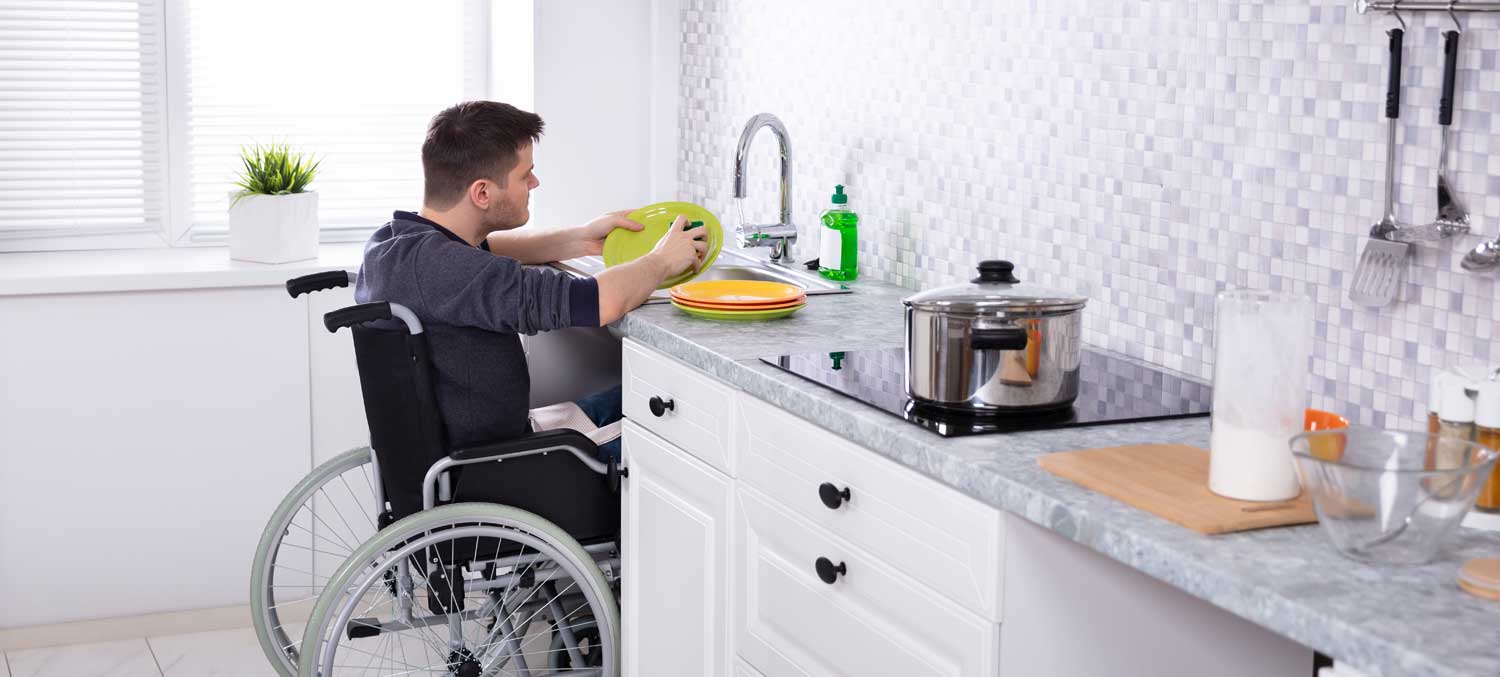
Learning how to cook after becoming a wheelchair user is a crucial part of rehabilitation. It is important that you provide yourself with nutritious and cost-effective meals from home, rather than solely relying on delivery and fast food. Here are some tips to make your time in the kitchen easier.
Update Your Appliances
For safety, your oven should have controls on the front of the range and not on the back. The good news is that this option is readily found on commercially available ovens and is not a special access upgrade.
A separate range and wall oven may be of interest to you if you’re doing a full kitchen renovation, as you can have some more control over placing the items at the perfect height for you. Some also like an oven whose door swings open rather than pulls down, as they find it easier to maneuver. Again, these options are widely available at home improvement stores. Make sure to take some time testing how easily you can open and shut doors, press controls and that you can reach all areas you may need to place a pot or baking dish.
Countertop Cooking for Safety
Small appliances like air fryers, convection ovens/toaster ovens, pressure cookers, slow cookers, and indoor grills, among others, can offer a convenient way to prepare meals while offering reduced risk of burns compared to stovetop cooking. Before purchasing any new gadgets, see if you can test the items on an in-store display. How easily can you open and close lids and doors, press buttons, and assemble and disassemble the appliance for cleaning? If the appliance is too burdensome to use, you won’t use it, so this is the time to go to a big box store and play with all the display items.
Save Time with Meal Kit and Delivery Services
From local restaurants to national brands, some options may fit into your budget to provide healthy meals that require no or low levels of preparation. Some programs offer meals as simple as going right into the oven/convection oven or microwave, with lower levels of sodium and preservatives as a frozen meal you will find in the grocery store. Others offer pre-cut ingredients, so you can still control the seasonings and cooking temperatures, with a lot less prep time than starting from scratch.
Note: You may wish to speak with your doctor or a nutritionist about the specific nutritional needs you may have, especially if you have a Spinal Cord Injury/Disease.
Don’t Forget your Mise en Place
Mise en place is a French term meaning “everything in its place.” In your kitchen, it’s the preparation of all ingredients before cooking begins. Suppose you find yourself needing to take frequent breaks while cooking. In that case, it’s especially beneficial to measure and cut before starting the cooking process to prevent burning or overcooking anything.
Prep on a Table or Lap Desk
If your counters are too tall to comfortably chop, mix and sort, consider using a lap desk, putting a cutting board on your lap, or simply moving to a table that’s at an appropriate height for your wheelchair, with enough room underneath for you to fit.
Embrace Frozen or Store Pre-cut Produce
If the prep work needed to prepare fresh vegetables steers you away, look for pre-cut vegetables in your grocery store’s fresh produce section, or peek in the freezer section. While pre-cut vegetables are a bit more expensive than whole vegetables, it’s still a better value than throwing out vegetables that you didn’t have the time or energy to prepare! If you’re budget-conscious, stick to paying for the upgrade on the items you find most difficult or time-consuming to prepare, like sweet potatoes and spaghetti squash.
Frozen vegetables are a very healthy and convenient option, especially as vegetables picked for freezing are often left unpicked to ripen longer than their fresh counterparts. Unless the vegetables are prepared in heavy, creamy sauces, they’re an excellent option as both a shortcut and a meal booster.
Adaptive Tools are Everywhere
There are adaptive kitchen tools for almost every need, from utensils that are easier for those with difficulty gripping to a grabber tool to reach items in cabinets. Identify the items and tasks that are most difficult for you, and an internet search can show you tools that were either specifically developed to assist disabled people or mainstream items that work as an off-label “hack.”
Most importantly, you need to be comfortable in your kitchen, so adapt the space to you, whether it’s using a lap desk on your wheelchair, simplifying your meal prep, or doing a full remodel to include wheelchair ramps. Outsource the things you can’t do to find new ways to prepare and enjoy your favorite dishes.

Don’t Risk Injury To You Or A Loved One
Why wait? Give us a call at 877-596-7293 or contact us online to get started!